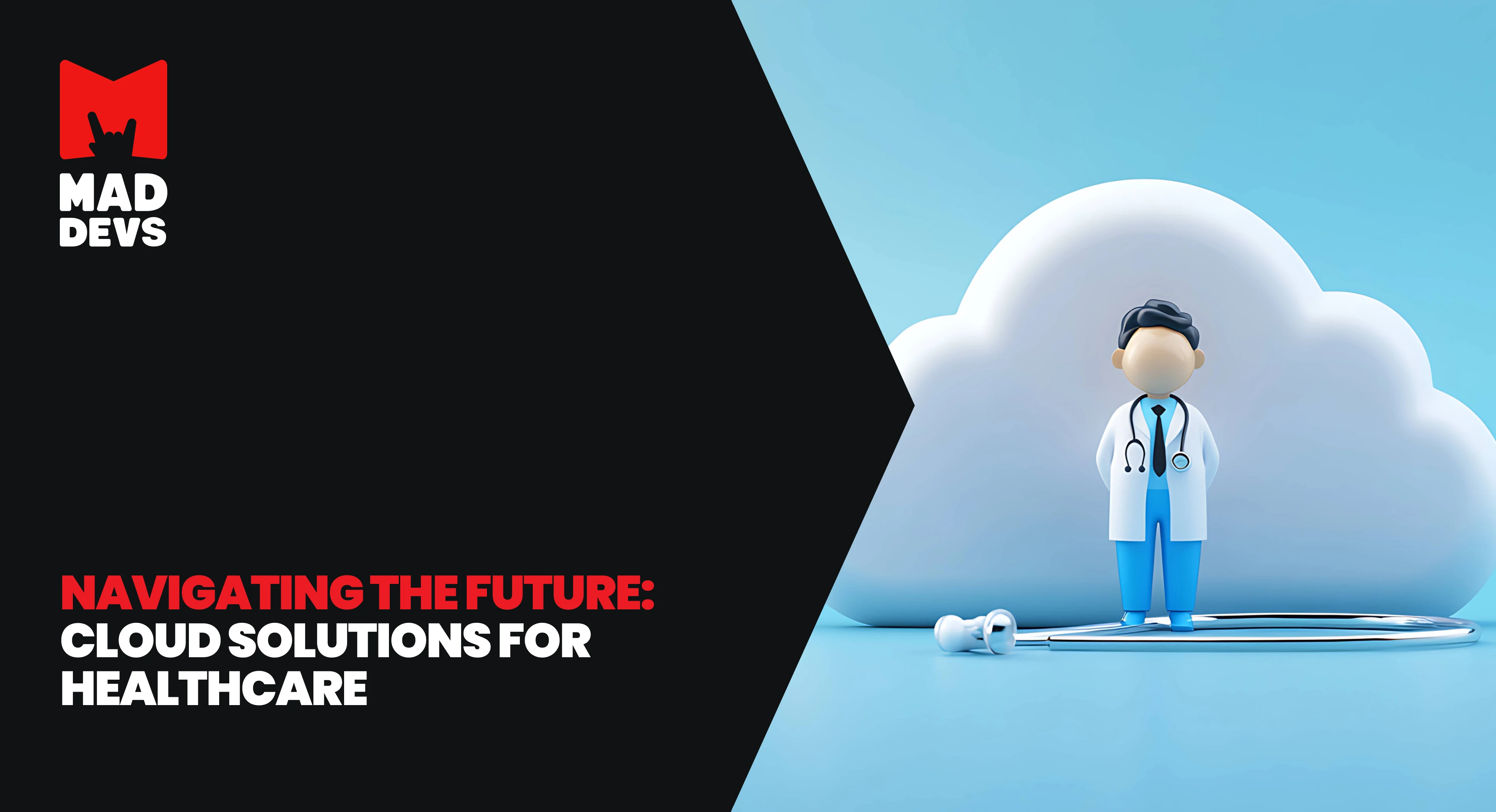Organizational resilience is an indispensable aspect of the contemporary world, where the notions of volatility, uncertainty, complexity, and ambiguity (BANI) have become everyday realities. As Sheryl Sandberg and Adam Grant argue in their recent book, resilience can be compared to a muscle that contracts during prosperity and expands during adversity.
In this article, we will explore the concept of organizational resilience in the BANI world. We will examine how to balance resilience and flexibility in modern business and how to leverage this balance in strategic planning and organizational management in the BANI world.
What is the specificity of the BANI world
To address VUCA (Volatility, Uncertainty, Complexity, and Ambiguity), you need 4 key abilities: Vision, Understanding, Clarity, and Agility. While melodious in its syllabic match, this combination may appear somewhat overly simplistic. These abilities are not easily acquired or honed and may not provide a complete solution. Nevertheless, they serve as a valuable starting point.
In recent years, the VUCA landscape has shifted to a BANI framework characterized by Brittle, Anxious, Non-Linear, and Incomprehensible factors. Respectively, let's shift our focus toward understanding what it takes to navigate the unique challenges of living in a world of BANI.
Various factors have been identified as potential threats to organizational resilience, such as climate change, the rise of COVID-19, record inflation, and world conflicts. All of them will impact how organizations operate, leading to stress, disorientation, and disruption of work processes. Some organizations are closing down, others are restructuring, while the rest are trying to raise efficiency—optimization has become a major phenomenon in recent periods.
The advent of remote work, accelerated by the pandemic, presented a significant challenge for organizations across the globe. It demanded rapid adjustment to provide employees with essential tools and bolster their mental and emotional well-being to succeed in this virtual work environment.
This shift exposed previously obscured aspects of teams and priorities that were not well-defined when working within the traditional office setting. For many, this revelation has posed obstacles, impacting both their endeavors in digital transformation and the overall vitality of their organizations.
Businesses are trying to find explanations and solutions in an attempt to hold onto their positions. Let's see what is the peculiarity of the BANI world, and why it causes wariness:
- There are no guarantees about anything in investments.
- There may not be the "right" choice of assets, and performance is not guaranteed.
- Systemic influences may render all actions useless.
- There may be no obvious link between cause and effect.
- The result may take a very long time, and there may not be any result at all.
- The amount of information is more than an investor can digest, and finding the essence is harder than it seems.
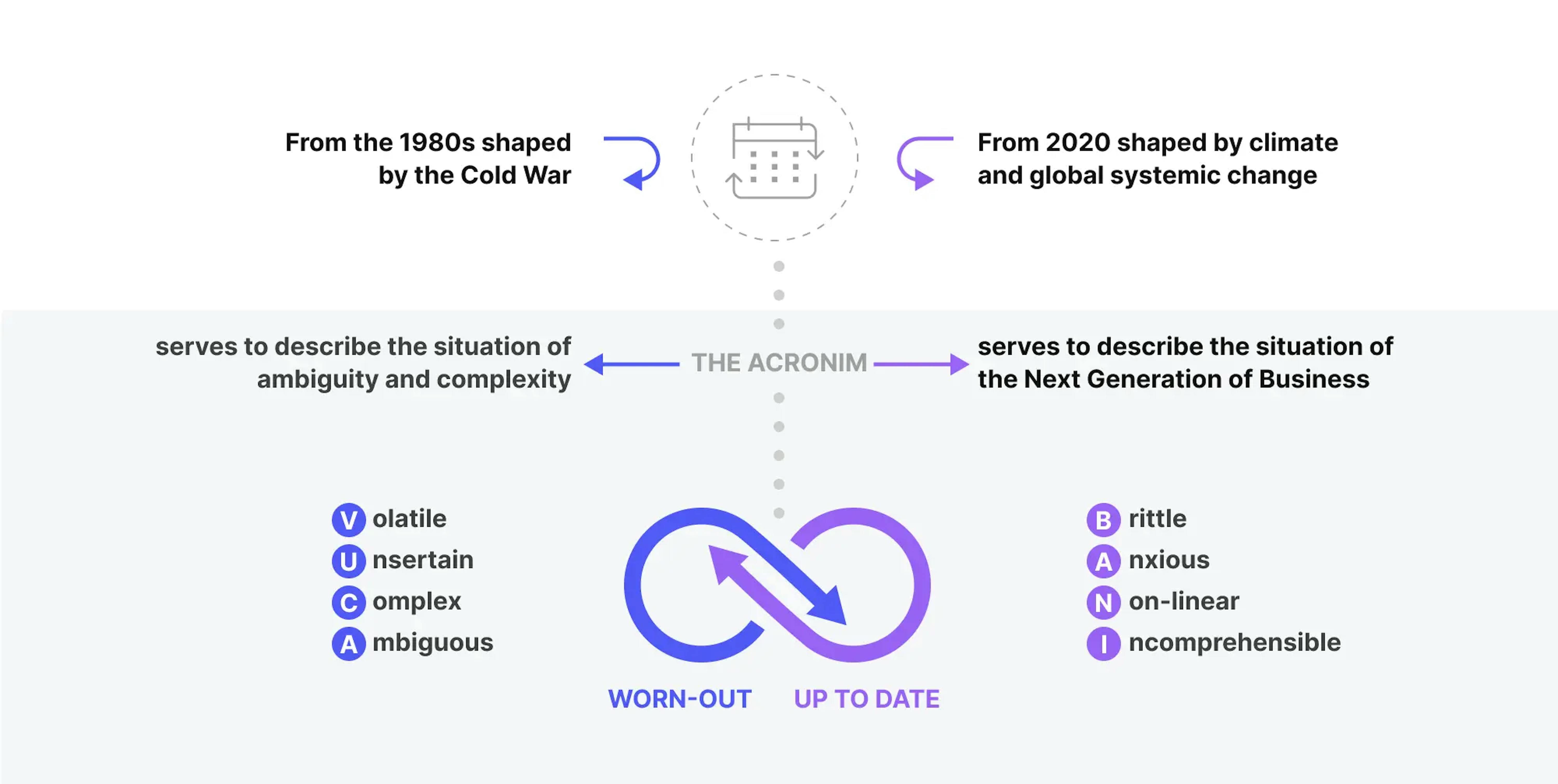
Why business acumen in a BANI world is important
Let's delve into the definition of business acumen. It entails the skill to integrate various elements to discern the most advantageous course of action in a given situation, facilitating prudent business decisions. You can apply business acumen in everyday scenarios, such as improving work efficiency or tackling workplace challenges.
While VUCA helps leaders grasp the concepts of volatility, uncertainty, complexity, and ambiguity and their relevance to their specific context, BANI assists them in comprehending and locating the impacts of these factors on individuals and organizations. For leaders to devise solutions to problems and pave the way for a brighter future, they must first recognize the unpredictable nature of our world and the limitations of control. BANI equips them to prepare for the post-pandemic world and any forthcoming uncertainties.
Skills such as communication, financial literacy, problem-solving, and more play a pivotal role in this preparedness. Let's delve into the details of how business acumen skills can be applied in each BANI scenario:
- Brittleness
Once leaders acknowledge that uncertainty is uncontrollable and embrace adaptability in the face of change, they become more effective in managing their teams and organizations. Mental resilience is a foundational trait of leadership. It's during times when the illusion of control shatters that leaders can truly showcase their capabilities. - Anxiety
Listening and emotional management skills are increasingly crucial in the business world. The pandemic has heightened the importance of empathy, especially for leaders who need to connect with their workforce's challenges. Fostering a sense of unity rather than an "us" vs. "them" mentality is essential. - Nonlinearity
In today's fast-paced world, agile leadership is imperative. Change is constant, and leaders must ask, "How can we adapt to a changing world?" or "How can we incorporate change into our business to avoid downturns?". - Incomprehensibility
It's crucial to overcome the fear of communicating problems and challenges. Transparent management is an effective strategy for tackling challenges, empowering leaders to take calculated risks and trust their instincts. When transparency is a cornerstone of leadership, leaders gain confidence in making decisions based on their judgment. Incomprehensibility arises when team members are unaware of their surroundings, which only exacerbates the issue if leaders withhold information from them.
In conclusion, business acumen is vital in the BANI world. It empowers leaders to navigate uncertainty, embrace adaptability, connect empathetically, drive agility, and promote transparency. These skills are essential for addressing the challenges posed by Brittleness, Anxiety, Nonlinearity, and Incomprehensibility, paving the way for a brighter future in an unpredictable world.
What will organizational resilience stand for in 2024
In the context of the BANI world for tech companies, resilience means having systems, processes, and plans in place to minimize the impact of adverse events on business operations and ensure the ability to recover quickly.
Many experts agree that certain areas will help strengthen business:
Increased focus on technology-driven solutions. Due to the increasing number of organizations globally relying on technology for their operations, they are expected to adopt technology-driven strategies to enhance their resilience and ensure business continuity in the event of disruptions. This can be done through automation, cloud computing, and artificial intelligence.
Emphasis on risk management. As organizations look to improve their operations, they are likely to place greater importance on risk management. This can be done by regularly conducting assessments, investing in early warning systems, and developing contingency plans.
Greater emphasis on mental health and well-being. Regarding the importance of employee well-being, as well as their role in organizational resilience, organizations are expected to place a greater emphasis on promoting mental health, especially during times when uncertainty and stress are prevalent.
Sustainability and green initiatives. To minimize their environmental impact and improve their sustainability to reduce their carbon footprint, organizations are expected to incorporate green initiatives into their planning processes. This can include adopting renewable energy sources, reducing waste, and developing more environmentally friendly business practices.
Remote work and hybrid models. With the rise of remote work due to the COVID-19 pandemic, organizations will continue to embrace hybrid models of work, with employees working from home and the office. This will require organizations to have robust technology and communication systems in place to ensure business continuity.
Continuous learning and development. Resilience involves a commitment to continuous learning and development. Organizations invest in upskilling and reskilling their workforce to remain competitive.
Ethical leadership. Ethical leadership and corporate social responsibility are central to resilience. Companies uphold ethical standards in their operations, fostering trust with employees, customers, and the public.
Global collaboration. Resilience extends beyond organizational boundaries. Companies collaborate globally with partners, governments, and other stakeholders to address shared challenges and promote collective resilience.
A tech company with strong organizational resilience will have robust infrastructure, regularly tested disaster recovery plans, and effective communication processes to ensure that the business can continue operating despite disruptions. This can help the company maintain customer trust, protect its reputation, and generate revenue during difficult times.
How Mad Devs resisted
In these turbulent times, the OKR (Objectives and Key Results) system has become an integral part of our Mad Devs strategy, helping us stay afloat.
Since 2021, we have actively implemented the OKR system, and these changes have not gone unnoticed. In an unstable world where flexible strategies and agile adaptations are required, the OKR system has provided us with the means to quickly adjust our goals and plans. Our impressive achievements exemplify how important it is to adapt to new realities and find ways to solve problems. During this time, we worked on several projects, which you can find on our case studies page.
The first thing to note is the shift in our focus on objectives and key results. OKRs have helped us better define priorities and concentrate on the most important tasks. This focus has improved our planning and enabled us to achieve clearer and more measurable results.
We are a remote-first team, so OKRs have become a key tool in strengthening the connection between our remote employees and our central offices. Every team member understands their contribution to our overall success thanks to well-defined objectives and key results. This fosters more productive work, regardless of our team members' locations.
We have observed a significant improvement in performance metrics due to implementing OKRs. This helped us achieve higher efficiency in task execution, enhance product quality, and manage resources more precisely. Clarity and transparency are the contributions that OKRs have brought to our organization.
CSO Mad Devs's forecasts
Oleg Puzanov, our CSO, shared his main observations, which tools helped our company to endure.
1. We moved away from the concept that we are a development-only company. We are talking about the diversification of resources. In addition to software development, we have good expertise, which clients need. By sharing our knowledge as consultants, we responded to the market's demands. In this way, we strengthened the sustainability of our company.
2. Modern geopolitical conditions and the pandemic have slowly brought us to the point where the HR department has been transformed into a semblance of HR Care. People are our greatest resource. And it makes a huge difference in how you treat them within the company. It increases the loyalty and motivation of the staff. And this is an important tool for business development in any field.
3. Our mission is to automate. It gives enormous power to our risk management to withstand any unexpected events. We automate everything for clients and the whole routine in Mad Devs processes. From planning and budgets to task execution. We use an internal product called Enji.ai to do this. It allows us to respond quickly to problems. But beyond that, it's also a way to delegate responsibility to employees because they can track all the metrics themselves. Less bureaucracy, more freedom of information.
Not long ago, the Unicorn from KG competition was held in the High Technology Park and KSSDA. Enji.ai took second place and received a grant to complete the Hero Training acceleration program at Draper University in Silicon Valley.
4. Fixing all the processes is the key to stability. We have a large database of documentation, which details all the processes employees and customers may encounter. These are both managerial documents and engineering handbooks, which lead to observing basic development processes, communication, and so on. In a crisis, people tend to overreact to any deviations. And when there's a clear understanding, it gives us as a company and clients peace of mind.
5. What works must remain in the future. But beyond that, Mad Devs have identified several other trends that will strengthen the organizational resilience in the BANI world.
Hard skills have been replaced by soft skills. In a constantly changing world, awareness, sincerity, empathy, intuitive, adaptive thinking, and tolerance of difference and uncertainty come into play. This will be the opportunity for efficiency to exist. Therefore, the main investment should be in the development of people, in particular employees. The more mature and flexible people in companies, the higher the chance for business to survive.
The planning horizon is changing. Classical goal-setting for a year no longer works. It is important to learn to set goals at the probability level, considering the growth of technology and the monthly information volume. That's what tracking trends with AI, which can handle data in a short amount of time, are for. Here again, we come back to the importance of nurturing a workforce that is capable of implementing new trends and tools.
Market trends in 2024
| IT Outsourcing | AI and ML Technologies | Cybersecurity | Cloud computing | Blockchain |
|---|---|---|---|---|
| Revenue in the IT outsourcing segment is projected to reach $156.20 billion in 2023. | The AI market was valued at around $134.55 billion in 2022. It is expected to grow at a compound annual growth rate (CAGR) of over 38% from 2023 to 2030. | By 2023, about 65% of the world's population will have their personal data covered by privacy regulations, which is up from 10% in 2020. | The global public cloud is expected to grow from $595.5 billion in 2023 to $864 billion in 2025. | The global blockchain market should reach $39.7 billion by 2025. |
Tech budgets are expected to grow in 2024, two-thirds of businesses (66%) said they plan to increase year-over-year tech spending, while only 4% plan to decrease spending. The remaining 30% will keep their tech budget level.
Tech spending is projected to total $183.8 billion in 2024, up from $176.8 billion in 2023. In comparison, global tech spending is projected to total $5.1 trillion in 2024.
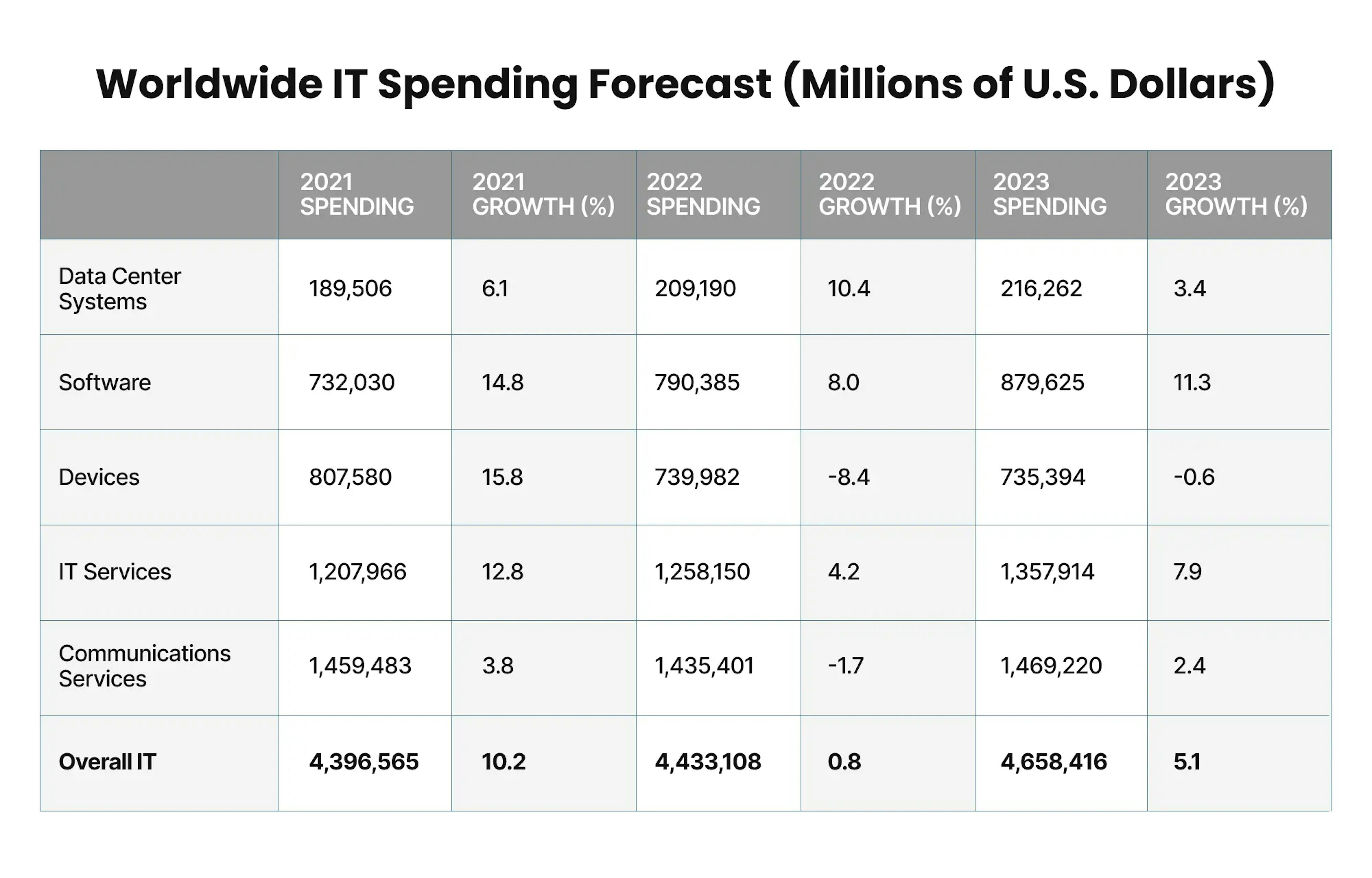
Worldwide IT Spending Forecast (Millions of U.S. Dollars)
Outsourcing is sweeping away the old ways
First, we will define the difference between outsourcing and outstaffing. The difference lies in how the work is contracted and the level of control over the employees involved. Here's a breakdown of the two concepts:
Outsourcing:
- You have a one-off project that you need to get done, but you don't have the resources to do it in-house.
- You need to outsource a task that is not core to your business, such as customer service or tech support.
- You need to outsource an expensive task to do in-house, such as manufacturing or software development.
Outstaffing:
- You need to hire additional employees to work on a specific project, but you don't want to commit to hiring them full-time.
- You need to hire employees with skills and experience that are difficult to find in your local market.
In the current landscape, the shift from the traditional outstaffing model to BOT (Build-Operate-Transfer) is undergoing notable transformations, reshaping the way organizations manage their operations. This evolution is evident across three pivotal phases:
In the "Build" phase, we lay the foundation for the operations. This involves assessing project requirements, identifying suitable candidates for specific roles, determining salary structures, and facilitating the onboarding process into your organization. We set up the necessary technology, infrastructure, and resources to establish a fully functional outsourced operation.
In the "Operate" phase, we provide knowledge transfer, training, and documentation to facilitate a seamless transition of the outsourced operation to your management team. This component encompasses employee development in both technical and personal aspects, access to the knowledge base, methods, and experts at Mad Devs, as well as participation in professional communities and assistance during project execution.
The "Transfer" phase is for managing the day-to-day operations, performance monitoring, and improvement of the outsourced operation. Under this aspect, you have the option to request a replacement for an employee if necessary, choose not to hire an employee directly, and facilitate the transfer of an employee to your team.
This transformation underscores the advantages of the BOT model, where we not only provide skilled resources but also collaborate closely with your organization to ensure a successful and sustainable transition.
Back to outsourcing, business leaders believe remote teams help improve productivity and accelerate time to market because of their diverse expertise and well-designed management processes. The tech outsourcing segment is projected to reach $98 billion in 2024, according to Technavio. This represents a CAGR of 5% from 2020 to 2024. The annual revenue growth rate (CAGR 2023-2027) is expected to be 7.49%, bringing the market to $208.50 billion by 2027.
Outsourcing software development to startups is expected to grow by 70% between 2022 and 2023. At the same time, midsize companies and enterprises need software development support to improve ROI and customer service in a tight timeframe. Due to the popularity of outsourcing, its market is constantly growing and will continue to grow in the future.
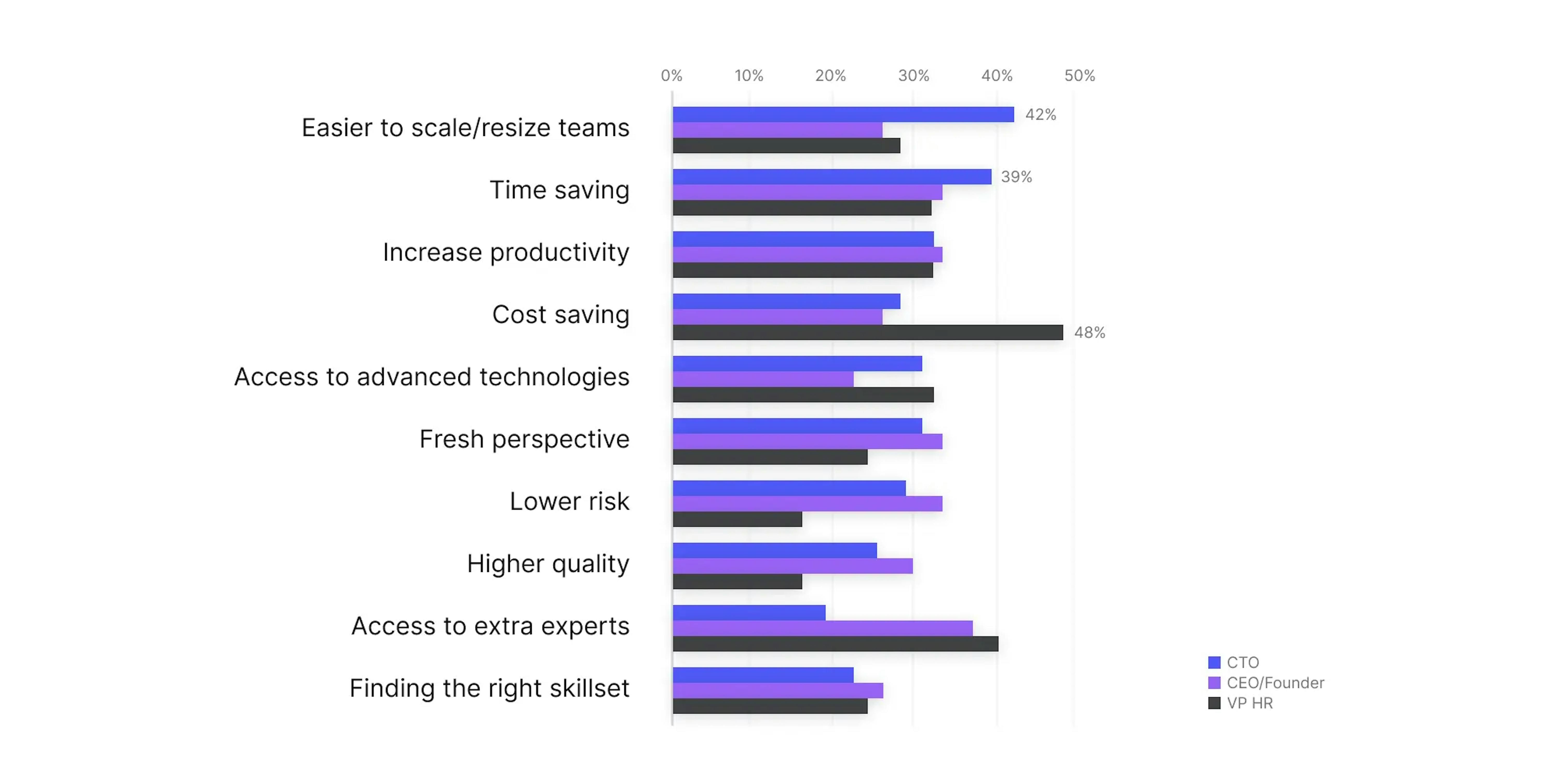
A Deloitte study found that the most common reasons for outsourcing programmers include the following:
- Cost savings
- Paying more attention to the core business
- Solving productivity problems
- Quality improvement
- Access to a talent pool
- Other business needs
Key findings:
Tech outsourcing service providers are implementing detailed data protection policies and acting in compliance with the CCPA, GDPR, and other international and local regulations. Thus, they are now allies for businesses seeking to create highly secure ecosystems.
Customers want to move forward with flexible collaboration strategies that save investment and avoid downtime. They are more likely to pay for their work using a time and material payment method instead of a fixed price.
Outsourced teams are here to bring tech and non-tech values: the ability to provide a single vendor for all of the company's needs. It means that future tech outsourcing service models may involve transforming the operations of these providers to become consultants, analysts, developers, and marketers in one box for their clients.
Over 400 million global users now own cryptocurrency, fueling demand for better payment methods. Major companies like Namecheap, Virgin Galactic, and Microsoft have adopted crypto payments since 2014. Key benefits: enhanced security, faster transactions, and broader financial access.
By 2040, 95% of purchases may happen online. This leads to increased cybersecurity needs, especially in 2024, with rising tech outsourcing trends favoring Managed Security Service Providers (MSSPs). MSSPs offer cybersecurity services to various sectors, helping businesses fill staffing gaps, access expertise, ensure 24/7 protection, and achieve cost-efficiency. Popular cybersecurity solutions include intrusion detection, access control, and proactive threat searches. Utilizing MSSPs often proves more effective than in-house security operations.
2024 was fruitful for promising partnerships, and the tech outsourcing market remains suitable for investors.
Humans stay behind, AI takes a step forward
Tech companies will increasingly integrate AI and ML technologies into their systems and processes to improve decision-making, automate repetitive tasks, and drive innovation. This will involve using natural language processing (NLP), computer vision, and predictive analytics. By leveraging these technologies, tech companies will be able to gain a competitive advantage and better meet the needs of their customers.
As the number of applications that are capable of using AI increases, people will start to realize the capabilities of this technology in their daily lives. Some of these include applications that allow people to create complex reports and visualize data with just a mouse click.
The availability of low-code and no-code platforms has made it easier for people to develop and test artificial intelligence-powered software. This makes it possible for anyone to create and implement applications that are simple to use.
Top niches where low code will be in demand in 2024:
- Applied and generative AI
- Immersive virtual experiences
- Robotic process automation
- Green technologies
- Cloud and edge computing
- Quantum computing
The democratization of AI will help organizations overcome the skills gap that has hindered the development of AI. This issue is caused by the lack of qualified individuals capable of handling the various tasks involved in using AI. It is important to note that AI will not replace individuals. People effectively use AI as a tool to replace certain functions and facilitate various activities.
Salesforce mentioned that sales automation increases productivity by 14.5% and helps reduce marketing costs by 12.2% needs of their customers.
European companies will also invest in upskilling their existing workforce to ensure they are well-equipped to work with these new technologies.
As companies start to make their models more interpretable, the trust levels in the ecosystem will increase.
According to a study from Juniper Research, about 8.4 billion voice assistants will be in use in 2023.
The global machine learning (ML) market should grow to $209.91 billion by 2029 at a compound annual growth rate of 38.8% over the forecast period 2022-2029.
Engineers are constantly trying to improve their understanding of machines by teaching them to collect knowledge instead of just looking for patterns. Foundation models are very useful in various tasks, such as translating and coding, customer support, and content generation. Examples of well-known foundation models include GPT-3 and Midjourney.
The increasing number of trust levels in ML models being made by companies will help pave the way for an era of augmented reasoning and decision-making.
All the above will allow machines and humans to work seamlessly together.
Cybersecurity: where to look
The increasing importance of ransomware attacks and data privacy laws has driven the focus of risk and security leaders. They are also increasingly looking into board-level audits and cyber-physical systems.
According to the Global Outlook report, business and cyber leaders believe global geopolitical instability is moderately or very likely to lead to a catastrophic cyber event in the next two years. And there are already tremendous changes taking place to respond to today's risks.
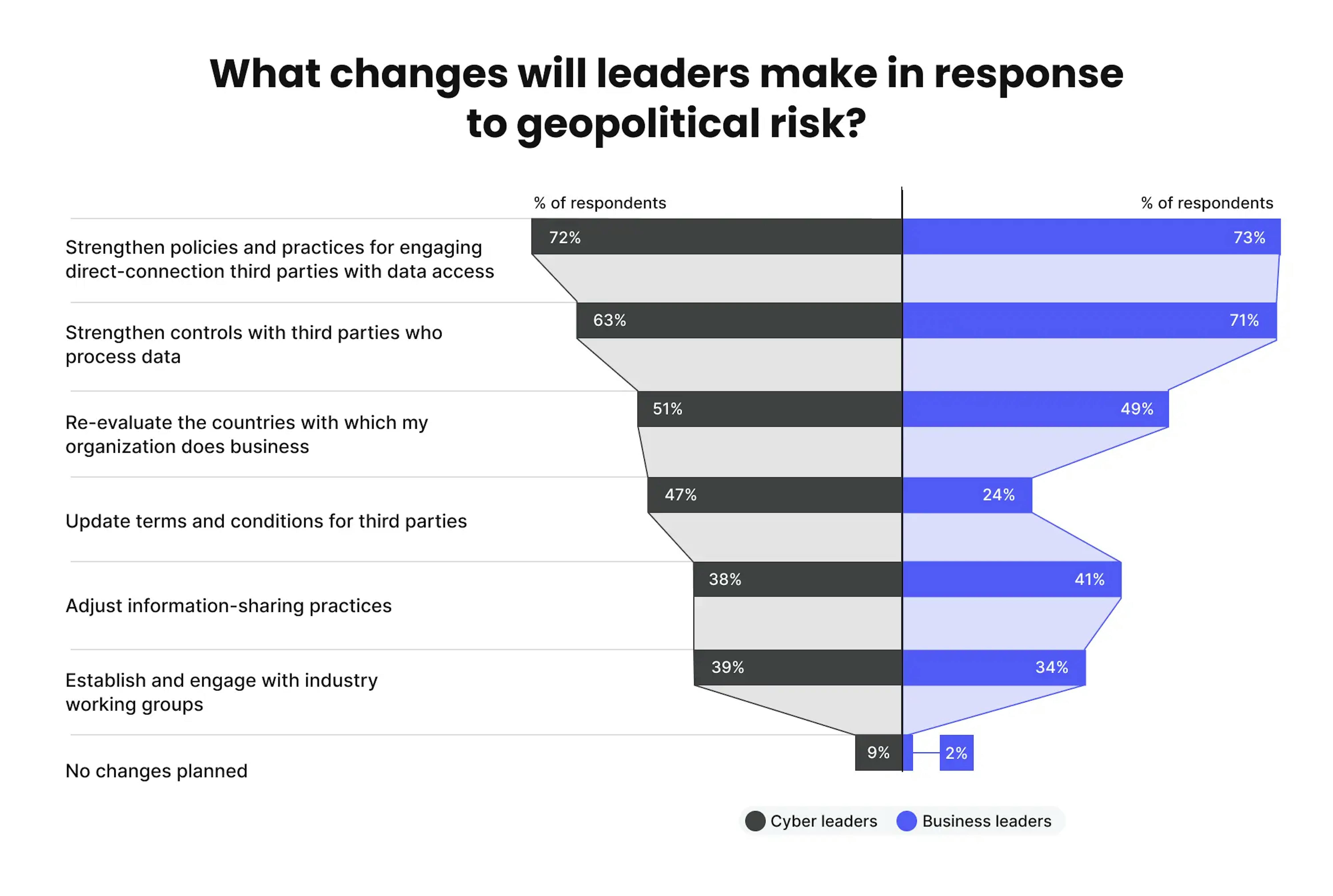
What risks is everyone talking about? Here is the list of the main ones:
- Increase in AI-powered cyberattacks
Cybercriminals will use AI to automate tasks such as scanning for vulnerabilities and launching phishing attacks, making their attacks more efficient and effective. They will also use AI to evade detection by security systems, making it harder for organizations to protect themselves. - The emergence of new ransomware variants
Ransomware attackers will use new techniques to infiltrate systems, such as exploiting zero-day vulnerabilities and using sophisticated social engineering tactics. They will also use new encryption methods that are more difficult to break, making it harder for organizations to recover their data. - Cloud security concerns
As more companies store sensitive data in the cloud, there will be a greater risk of breaches and unauthorized access to that data. To address these concerns, organizations will need to implement strong security controls and closely monitor their cloud environment for potential threats. - The Internet of Things (IoT) security challenges
With the growing number of IoT devices in use, there will be an increased risk of attacks on these devices, such as hijacking them for use in a botnet or using them to steal sensitive data. To address these risks, organizations will need to ensure that their IoT devices are properly secured, with secure software updates, strong passwords, and other security measures in place. - The growing importance of 5G security
As 5G networks become more widespread, they will become a new attack vector for cybercriminals. Attackers may exploit vulnerabilities in 5G infrastructure to gain unauthorized access to sensitive data or to launch large-scale attacks such as DDoS attacks. To mitigate these risks, companies must ensure that their 5G networks are properly secured and that they have the necessary security controls in place to protect against potential threats.
Cybersecurity will continue to be a critical issue for organizations as cybercriminals use increasingly advanced tactics to infiltrate systems and steal sensitive data.
Experts agree that there are certain points worth paying attention to in 2024:
IT companies will need to stay ahead of the curve by developing and implementing new security technologies and techniques to counter these threats.
AI and machine learning will play a major role in the threat landscape and cybersecurity defenses, as cybercriminals use AI to automate their attacks and organizations use AI to detect and respond to threats in real-time.
The cloud, IoT, and 5G will all be major areas of focus for IT companies, as they represent new attack vectors for cybercriminals and new security challenges for organizations.
IT companies will need to work closely with their clients to educate them on the latest threats and to help them implement effective security measures to protect against those threats.
Zero Trust is redefining cybersecurity by not inherently trusting any entity, internal or external. In 2024, it gained momentum, focusing on strict identity verification, continuous monitoring, and reducing attack surfaces. This approach enhances security and minimizes vulnerabilities.
In 2024, data privacy will gain importance, leading to the adoption of privacy-preserving techs like homomorphic encryption and federated learning. These methods protect sensitive data while allowing valuable insights, balancing security and privacy.
In conclusion, tech companies will need to be proactive and agile in their approach to cybersecurity, staying up-to-date on the latest threats and technologies and working closely with their clients to ensure their systems and data are secure.
Cloud computing: no time for blue-sky thinking
The increasing number of people and organizations using public cloud services is driving the demand for these services.
Over the past few years, the growth of the public cloud services market has been impressive. Amazon Web Services, Google Cloud Platform, and Microsoft Azure have all seen tremendous increases in their usage and adoption.
The public cloud services market is expected to grow from $595.5 billion in 2023 to $864 billion in 2025, representing a compound annual growth rate (CAGR) of 12.27%, according to Statista.
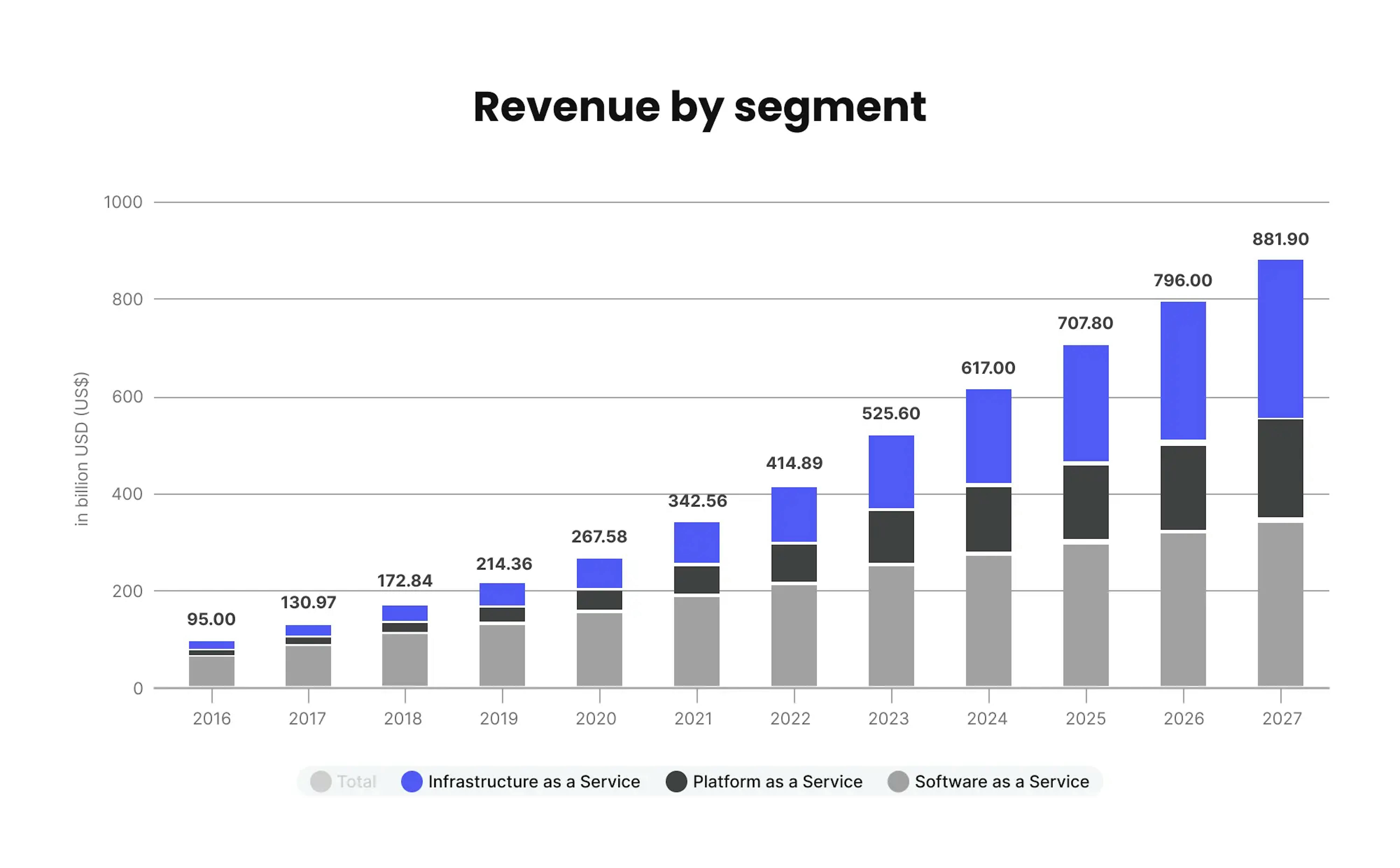
As organizations move their data and workloads to the cloud, they are also transitioning to software-as-a-service (SaaS) offerings, such as Salesforce and Office 365. According to a study conducted by IDC, the SaaS platform will be the largest segment of the public cloud computing market during the next five years.
The second-largest segment of the public cloud computing market is the infrastructure-as-a-service (IaaS), while the platform-as-a-service (PaaS) is also expected to grow quickly.
Top trends of cloud computing
Many organizations use public and private cloud solutions to meet their unique needs and optimize their workloads.
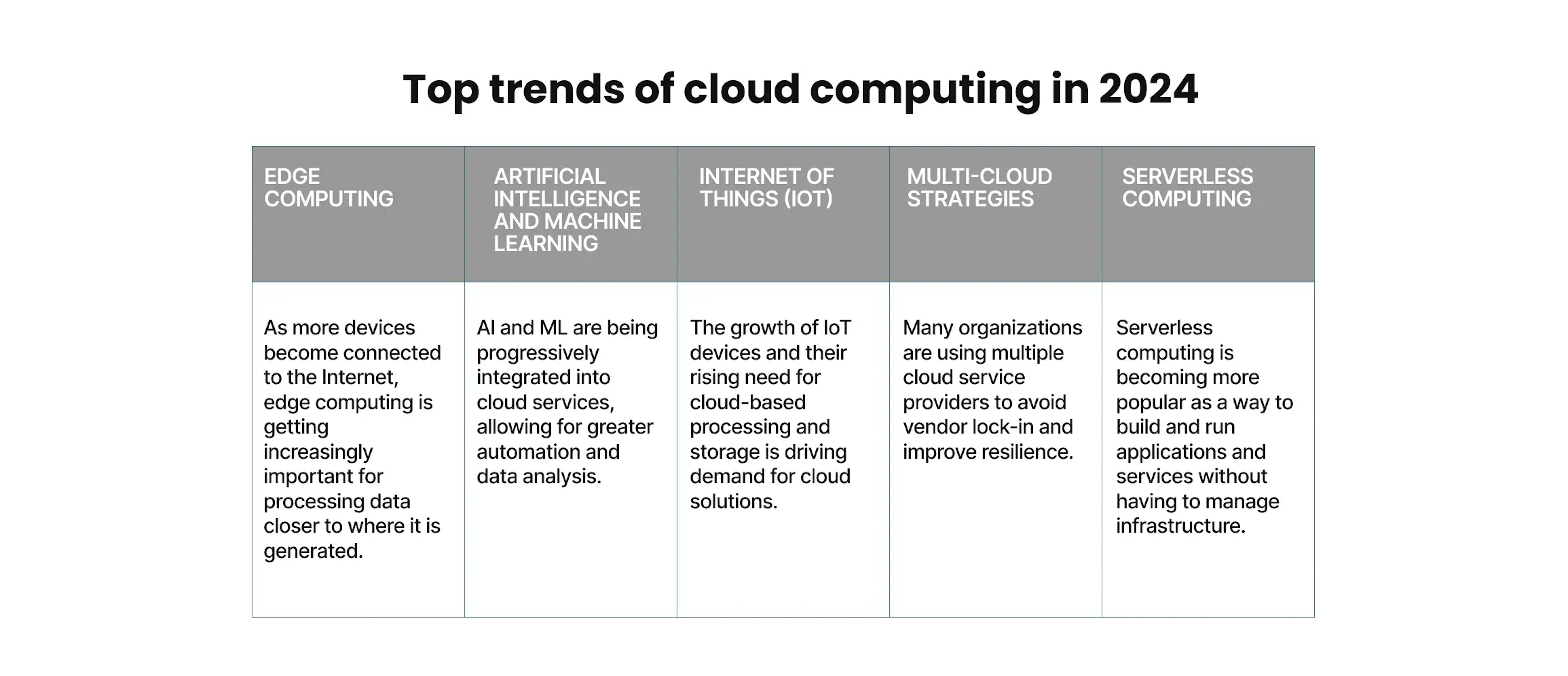
Based on these trends, we can outline the direction for future strategies in the next few years:
Keep an eye on serverless computing as a way to build and run applications and services. Consider choosing it over traditional infrastructure management to save time and reduce costs.
Look for multi-cloud strategies. Many organizations are using multiple cloud service providers to avoid vendor lock-in and improve resilience.
Adopt a hybrid cloud approach. IT companies should embrace a hybrid cloud strategy that leverages both public and private cloud solutions to meet the unique needs of their customers.
Focus on security. With more sensitive data moving to the cloud, IT companies should prioritize security and ensure that their cloud solutions meet industry-standard security certifications and regulations.
Embrace AI and ML. Tech companies should invest in artificial intelligence and machine learning to automate repetitive tasks, analyze large data sets, and provide customers with valuable insights.
Blockchain: The stakes go up
The blockchain market is expected to grow rapidly in the coming years, driven by increased demand for decentralized solutions, security, and transparency in various industries such as finance, supply chain management, and healthcare.
The global blockchain technology services market will grow from around $3.28 billion to almost $20 billion by 2027, with a CAGR of 45.5%.
The increasing number of private and public entities investing in blockchain technology is a major factor driving the growth of the global cryptocurrency services market. These organizations are expected to use it to develop new business models. Some of these include cross-border payments, internet banking, and trade finance.
The Asia-Pacific region was the largest contributor to the blockchain services industry in 2022. It was followed by North America in the global market in 2022. The other regions included in this study are Western Europe, South Africa, and Eastern Europe.
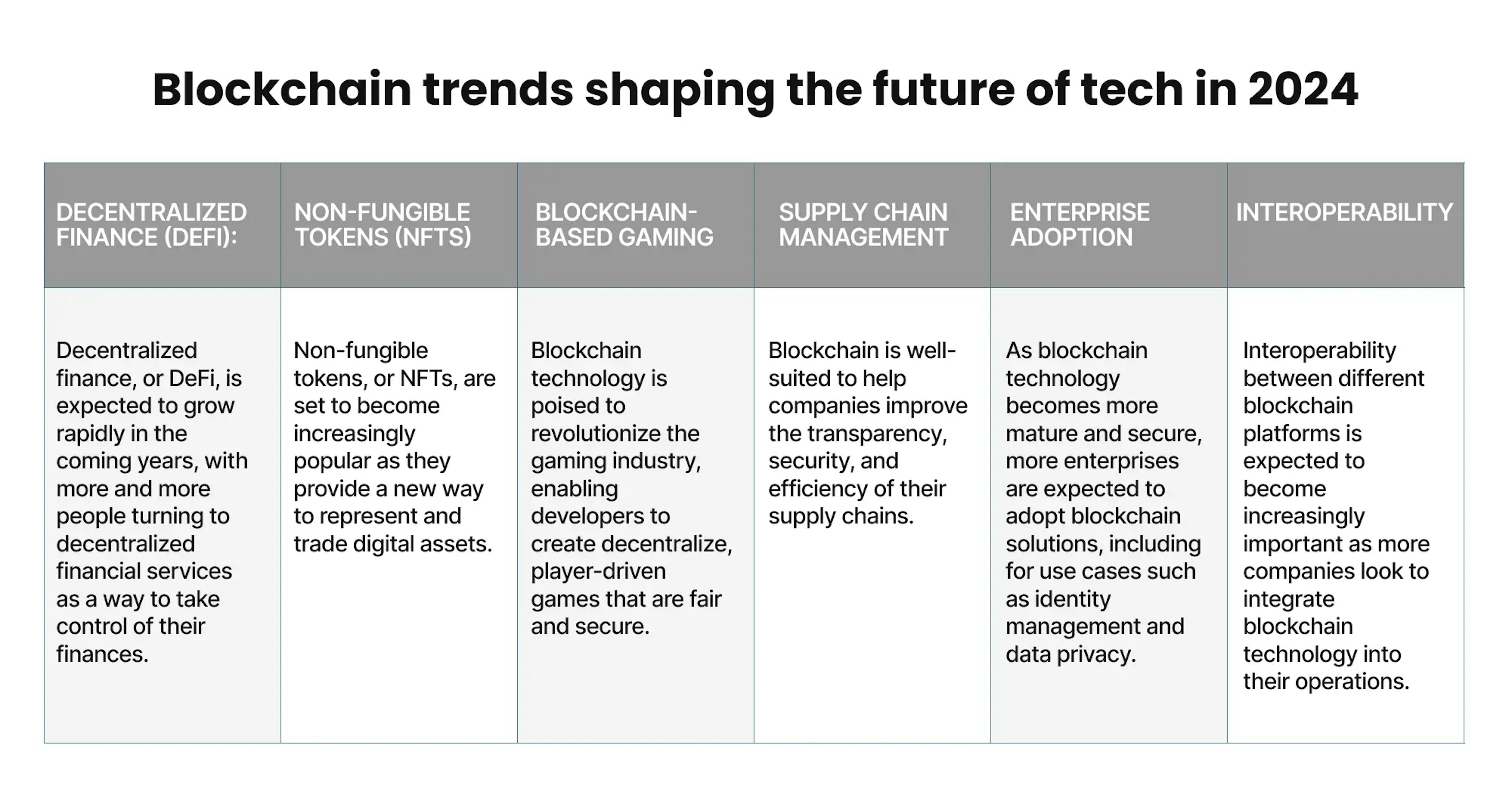
Besides that, it's important to mention the elephant in the room. Regulation is set to play a major role in shaping the future of blockchain technology in 2024 and beyond. The increasing popularity and widespread use of blockchain have led to a growing need for government oversight and regulations to ensure the technology is used securely and responsibly.
Some of the key issues that government regulators are looking to address include consumer protection, data privacy, and financial stability. For example, regulators may require blockchain-based financial services to comply with anti-money laundering (AML) and know-your-customer (KYC) regulations to prevent illegal activities.
In addition, regulators seek to promote innovation and encourage the growth of blockchain technology. For instance, some governments offer tax incentives or set up blockchain-friendly regulatory frameworks to attract blockchain companies and entrepreneurs to their jurisdiction.
Regulation is expected to play a major role in determining the future of blockchain technology and its widespread adoption.
Companies working in the blockchain space must be mindful of regulatory developments and comply with relevant regulations to be successful.
The year 2024 provides a huge field of work for tech companies. But to get down to it, it is important to ensure your sustainability to be ready for new dynamics in this new reality.
PayPal announced and in August '23 launched its own U.S. dollar-backed stablecoin, called PayPal USD (PYUSD). Their press release describes how PYUSD will bridge the gap between fiat and web3 currencies, making it easier for people to use cryptocurrencies in their everyday lives. Here are some of the key points:
- PYUSD will be available to consumers, merchants, and developers.
- PYUSD will be an ERC-20 token on the Ethereum blockchain, making it compatible with a wide range of wallets and web3 applications.
- PYUSD will be used to reduce friction for in-experience payments in virtual environments, facilitate fast transfers of value to support friends and family, send remittances or conduct international payments, enable direct flows to developers and creators, and foster the continued expansion into digital assets by the largest brands in the world.
It predicted that prominent financial institutions like JPMorgan Chase, Goldman Sachs, BlackRock, and Fidelity are leading the way in blockchain technology adoption. They are exploring asset tokenization and digital transactions to enhance their efficiency.
Blockchain enables real-world asset tokenization through smart contracts, potentially reaching $10 trillion by 2030, covering private-sector securities, funds, central bank digital currencies, and stablecoins. Despite challenges like differing views and public vs. private blockchains, Wall Street clients are increasingly involved.
Life after BANI
Futurist Jamais Cascio created the acronym BANI. He explained that it is "a way to assess better and respond to the current state of the world." As is already clear, the fragile, disturbing, nonlinear, and incomprehensible world of Cascio only sets up a transition to a more definitive reality, breaking the old and creating a new one. Experts gave BANI a lifespan of 5–7 years. The transition happened much faster.
This world already has a new name and more than one. These are also acronyms — SHIVA and TACI.
| BANI | SHIVA |
|---|---|
| Brittle | Split |
| Anxious | Horrible |
| Nonlinear | Inconceivable |
| Incomprehensible | Vicious |
| Arising |
The SHIVA world is distinct from the BANI concept. While BANI suggested fragility and some hope for survival, SHIVA represents a more severe reality. It signifies irreparable brokenness, causing previous methods to become obsolete. It's not just disturbing; it's paralyzing, hindering progress.
"Split" is not just broken. This means it cannot be repaired. In a management context, the meaning is this: previous methods, schemes, and models are outdated, ground into powder, and show no signs of life in the new reality. There is no use in using them.
The difference between "horrible" and "inconceivable" is about the same. In a background state of anxiety, you can act, look for new solutions, and move forward. Horror constraints do not allow you to take a single step, and prevent you from making operational decisions to confront challenges.
The "nonlinearity" of BANI predicted an imbalance in the results of actions taken or not taken. In the SHIVA world, nonlinearity has been replaced by "vicious." This is when there is no certainty that any decision can lead to anything.
Behind the "incomprehensibility" in BANI was the ultimate state of information overload, where acquiring more data could not be sure that it would improve understanding of anything. In the world of SHIVA, there is no chance to comprehend what is happening. At the same time, there is hope that when chaos sweeps away everything that exists, the world will reach the final stage of its fall, a new reality will begin to emerge in place of what was destroyed, and the time of "arising" will come.
| BANI | TACI |
|---|---|
| Brittle | Turbulent |
| Anxious | Accidental |
| Nonlinear | Chaotic |
| Incomprehensible | Inimical |
A common acronym was invented for another version of the world in which we found ourselves after BANI. Here, the creator followed the path of Cascio. Therefore, the name TACI does not immediately evoke any associations. To understand its essence, decoding is needed.
In its key definitions, the TACI world does not look frightening at first glance, and in some ways, it is similar to BANI because it does not contain an apocalypse that has taken place, but only its harbingers. At the same time, the idea that the global breakdown of the world order is inevitable also sounds from the first line.
The definition of "turbulent" here should be understood as "an exponential increase in the rate of multidirectional changes." The word "accidental" encodes unpredictability, uncertainty, and uncontrollability.
By "chaotic," it means the substitution and overturning of values, the destruction of logic and rules, the reality of the absurd, and the abolition of common sense.
Finally, "inimical" means a sense of danger and global existential threat, hypocrisy, cynicism, distortion of information and total lies, and an increase in senseless aggression.
From BANI and VUCA, only fragments remained according to the hypothesis of the creator of TACI. There is a lot of work ahead to create a new world. What it will be like depends on those who will shape it.




